
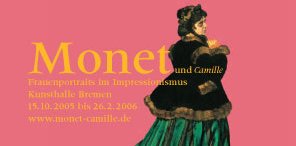
Monet and Camille
A Tour Through the Exhibition
See also : Monet and Camille : A relationship Biography
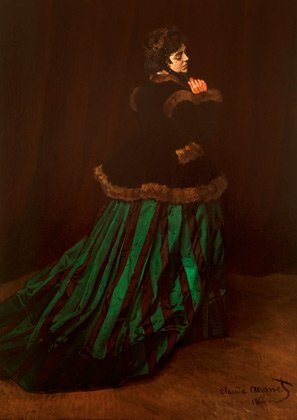
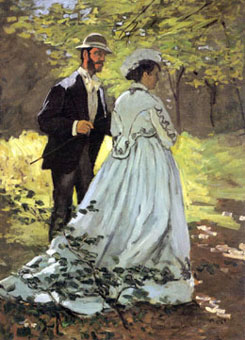
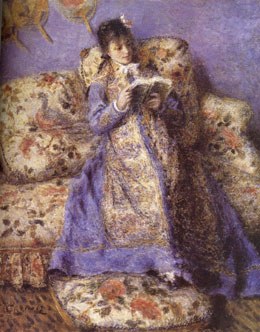
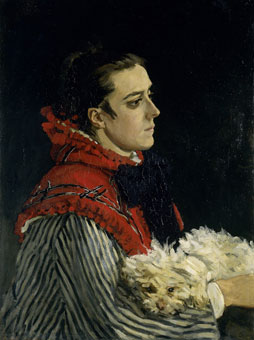
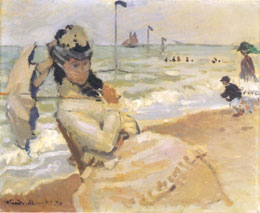
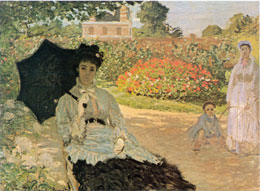

1) Monet and Camille – The Family
In the mid 1860s, Claude Monet was still completely unknown as an artist. For two years, the young painter had worked in the studio of Charles Gleyre in Paris, where he had met Pierre-Auguste Renoir, Frédéric Bazille and Alfred Sisley. All of them had only one goal: to show a painting in the Paris Salon. In those days, success in that annual exhibition was the basis for each and every artistic career.
It was roughly then that Monet first met Camille-Léonie Doncieux. She was 18 at the time, and Monet was 25. She was born in Lyon in 1847 and had come to Paris with her parents when she was a young girl. There, she began to work as a model for the ambitioned painter. But Camille was more than just a model for Monet: she was his friend and lover, and she became the mother of his two children. Camille accompanied Monet in the early years of his artistic career which were sometimes clouded by poverty. They married in 1870, three years after their first son, Jean, was born. She died in 1879 at the age of 32.
The Kunsthalle Bremen is introducing this little family to you in four portraits: Monet as an artist in his studio, Camille at the age of 19, and their two sons, Jean and Michel.
2) Early Paintings and The Picnic - On the Genesis of Camille
Today, Claude Monet is primarily known as a landscape painter, but in the beginning of his development as an artist, he used to concentrate on portraits and figure paintings. That becomes evident when we look at the Boy with a Pipe from 1864 and the Portrait of Victor Jacquemont Holding a Parasol.
Monet had been working on The Picnic since spring 1865, and it was meant to become his early masterpiece, showing several figures in a landscape. He had planned a more than six metres wide painting of stylishly dressed city dwellers having a picnic. In the preparatory studies on The Picnic, Camille appears in Monet's works for the first time. She is the female figure in the oil study The Strollers. But the huge painting was never completed. To still be able to draw attention to a spectacular picture in the 1866 Salon, Monet painted a portrait of a modern Paris woman: Camille.
3) Between Genre and Landscape - Camille's Role in Monet's Paintings
No one else is shown in Monet's paintings as often as his first wife, Camille. From the studies on The Picnic in 1865 to her early death in 1879, she is present in his works. At first, she appears in large-format figure paintings; from 1870 on, she is mainly to be seen as a subordinate staffage figure in genre paintings and landscapes. In 1879, Monet captured her one last time in his painting Camille Monet on her Deathbed.
The changing of Camille's role illustrates the development of Monet as a painter - from his early figure paintings to his Impressionist landscapes. At the same time, these paintings reflect stations in the lives of Monet and Camille: the summer of 1868 in Bennecourt, their honeymoon in Trouville in 1870, the British exile in 1870, the joyful years in Argenteuil from late 1871 to early 1878, and the tragic end in Vétheuil in 1879.
4) Camille and her Sisters - Full-Body Portraits of Women as Programmatic Examples of Modern Painting from 1860 to 1870
In 1866, Monet showed his painting of Camille in the Salon and met with great success. In this painting, he continued the traditional genre of life-sized full-body portraits that were made almost exclusively of the nobility. In these officially commissioned works, the public role of the portrayed person was highlighted, whereas the personal characterization was of less importance. With his Camille, Monet took a new path: he did choose the aristocratic genre of life-sized full-body portraits, but he painted "only" a bourgeois model, Camille, in front of an unassuming background. With the dress, the pose, and his brisk way of painting, he interpreted the entire theme in a completely new way.
Although Monet's young girl-friend is clearly recognisable, the intention of the artist was not to paint a portrait of an individual. Rather, he created a picture of an elegant young woman as a typical example of the Parisiennes. He thereby made a general statement on his time and lived up to the demand of the poet Charles Baudelaire included in his essay of 1863: to represent modern life.
Monet was not the only young artist in Paris to paint a large-format picture of a single standing figure in those days. Manet, Renoir and Carolus-Duran as well as Tissot and Whistler also dealt with this theme. Like Monet's Camille, their early figure paintings were not commissioned, either; instead, they represented their friends or models who can still be identified by name today.
It was highly unusual for these young artists to present such paintings of women in the Salon, as, at that time, portraits were regarded as commercially commissioned works and ranked low in the academic hierarchy of genres. Only when one no longer speaks of the represented person when looking at a portrait, but of the way it is done, and of what it has to say in general about an epoch, it can become a piece of art (tableau) in a higher sense. That was exactly what the young artists aimed for: they turned their portraits of women into programmatic examples of their new way of painting.
5) Salon Artists as Painter-Couturiers - Fashionable Portraits and an Elegant Genre
Small-format representations of fashionably dressed women in noble interiors had already been very popular since the late 1850s. The inventor of this new type of picture was the Belgian Alfred Stevens. He painted elegant young women who were busy doing quiet things while they were by themselves in luxurious living spaces. His brilliant fine paintings have subtle anecdotal details, so they can be called genre paintings.
The portraits of women by the French artist James Tissot are embellished with so many narrative elements that they come close to the quiet genre paintings of Stevens. Here, the lines between the genres become indistinct. Both artists painted their representations of modern Paris women in a true and academic way and found favour with the public in doing so. Modern-thinking critics, however, derisively named artists like Stevens and Tissot "Painter-Couturiers" on account of their careful representation of the garments. They were called "tailors whose only concern it is to satisfy their customers."
6) The Influence of the Popular Media - Drawings, Photography, Fashion Illustrations
For their full-body portraits of women, progressive painters such as Monet, Manet and Renoir let themselves be inspired by the popular pictorial world of their times. The former news illustrator Constantin Guys was taken as an example. Although he only drew pictures, Charles Baudelaire considered him the epitome of a "painter of modern life". His favourite motifs were figures from the Paris red-light district: he characterised Parisian types of women - from the cheap prostitute to the demi mondaine, but the true femmes du monde often came strikingly close to the grandes cocottes.
Already in the nineteenth century, Paris had been the centre of the international fashion world which became particularly inspiring for many painters. Around the middle of the century, the first large department stores were opened - true consumption temples of fashion - and, for the first time, outstanding tailors were celebrated as brilliant designers. Numerous illustrated fashion magazines were launched. In them, young artists found idealised figurines in intriguing poses which served to effectively show the fashionable silhouettes of the dresses they were wearing. In the 1860s, photographic portraits in the small carte de visite format were very popular. Even for them, full-body representations were characteristic. Photography was still young in those days, and the painters were greatly interested in it; but, on the other hand, photographers also took over presentations, poses and attributes from paintings.
The purpose of all of these media was to present fashionable clothes, and the same applies to most of the paintings in this exhibition. Moreover, three historical gowns convey a vivid impression of the sensual presence of the fabrics and silhouettes.
7) Monet, Renoir and Carolus-Duran - Early Commissioned Works
Soon after Monet, Renoir and Carolus Duran had exhibited the portraits of their friends in the Salon, they received orders for representative paintings from the bourgeoisie. Now they had to bring their artistic ambitions in line with the ideas of their clients.
The three artists dealt with this task quite differently: in his Portrait of Madame Gaudibert, Monet did paint a representative interior, but he showed only a lost profile of his model, so her face can hardly be recognised. That way, he refused to go along with the main purpose of bourgeois reminiscent paintings. He soon gave up painting portraits altogether and became a pure landscape painter.
Renoir, on the other hand, tried to balance his liberal artistic style and the representative purpose of a portrait. In the late 1870s, he created several paintings ordered by collectors and intellectuals.
Carolus-Duran came closest to meeting the expectations of his clients. His Portrait of Madame Feydeau is an adaptation of Monet's Camille to the taste of a broad public: his model turns her face towards the viewer, and its individual lines have carefully been worked out. Even her pose and the way her clothes are painted comply with her representative demands. Hence, Carolus-Duran became the favourite portraitist of the Parisian upper middle classes.
8) Small-Format Variations - A Fashionable Genre in an Impressionist Style
Full-body portraits of women were not only done in large formats. Pierre-Auguste Renoir, for example, transferred the motif into smaller formats in the 1870s and incorporated it in genre-type situations such as strolling, reading, or taking care of pets. The compositions and the narrative style of his paintings thus verged upon the popular single-figure genre such as Alfred Stevens had been cultivating since the 1850s. At the same time, however, he transformed this genre into an Impressionist style.
Here, too, the lines between genre and portrait are indistinct: the painting Camille Monet Reading is an individual portrait, but it shows the model in her domestic environment, doing something quite normal.
9) The Painted Surface 1870/80 - New Artistic Paths in the Decade of Impressionism
Despite their early success with Camille or Lise, Monet and his friends later kept being rejected by the conservative jury of the Salon. 1874 was the first year in which they therefore organised an independent exhibition to show their works. Here, Monet's painting Impression, soleil levant was also shown, which made a critic disparagingly call the artists "Impressionists". Although they differed greatly in style, they were all interested in motifs taken from modern life, and they all had a free, individual technique. Today, the 1870s are considered the prime of Impressionism.
In those years, life-sized portraits of women were established as a representative genre for bourgeois clients, and the artists now varied the compositions and the way they painted. Among progressive painters, the artistic structure became more and more important and was now even considered more essential than the identity of the portrayed person. The masterly style, the lack of details, and the plainness of the colours led to a completely new directness of expression, independent of the facial gestures of the depicted person. That becomes particularly evident in the paintings of Edouard Manet and James McNeill Whistler.
The other portraits in the last room of the exhibition also illustrate the broad range of artistic possibilities. Edgar Degas, for example, combines a complex statement with an innovative way of painting and nevertheless achieves an almost classical ease of composition and tone. In a similar way, Camille Corot's painting also calls to mind the Ancient World, in spite of the modern dress his model is wearing.
The successful society portraitist Henri Gervex, on the other hand, creates a mixture of Impressionist open-air painting and academic figure drawing which has public appeal. And Théo van Rysselberghe, too, combines tradition and innovation: on the one hand, he continues the decorum of representative portraits of the nobility, but in doing so, he uses a highly modern technique for the first time - Pointillism.
In the 1880s, the Impressionists gradually lost their interest in large portraits, and the commissioned painters such as Gervex and Carolus-Duran took over the lead - until the next renaissance of large-format portraits of women emerged in Symbolism and Art Nouveau.